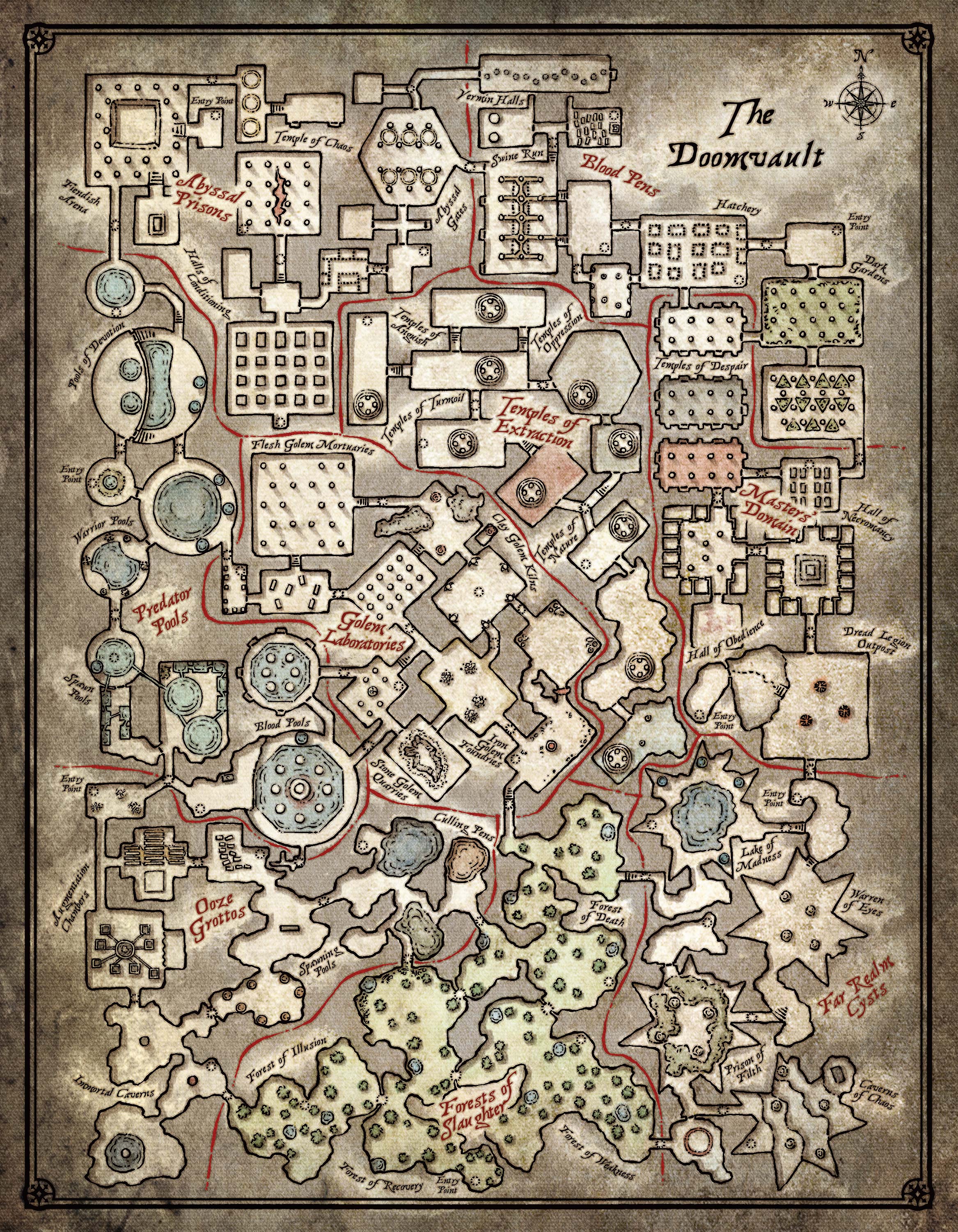The Doomvault
They must assault the Doomvault quickly — the more word gets out about their activities, the more the site’s guards will be on alert.
The Doomvault is divided into nine sectors that each focus on a different theme; Abyssal Prisons, Blood Pens, Masters’ Domain, Far Realm Cysts, Forests of Slaughter, Ooze Grottos, Predator Pools, Golem Laboratories, and Temples of Extraction.
A sector is split into four zones, that each explore one facet of that theme with a number of areas detailing a particular example. Magic gates separate zones from one another.
Magic secures the dungeon. No spell or trait allows anyone to evade the dungeon’s security. No spell permits teleportation out of the zone in which the spell was cast.
Gates
Each sector is subdivided into protected zones for security, defending against attack from outside and betrayal from within, as well as the escape of confined creatures. Magical white gates block corridors, preventing physical access between zones. Magical black gates are teleportation circles that connect different parts of the dungeon. Magic keys allow the manipulation of them. Each gate is a 10-foot-wide circle of runes, drawn on the floor. This circle creates a magical energy field in its space from floor to ceiling.White Gates
A ten-foot-diameter circle of runes and clear quartz fragments is set into the floor. Within the circle, a luminous white mist shimmers, obscuring what lies beyond.
White gates are placed in the dungeon to block passage between zones. A white gate’s misty energy field, when active, gives off dim light and renders its area heavily obscured. This field is also an impenetrable magical force that blocks passage (material and ethereal), sound, and scent.
If a glyph key attuned to the zone on either side of the gate is applied to the gate’s field, the mist dissipates and the energy field becomes inactive while the key remains within the gate. Therefore, a creature that has a properly attuned glyph key can hold a white gate open for others.
Black Gates
A ten-foot-diameter circle of runes and black onyx fragments is set into the floor. It exudes wisps of shadowy energy that look like curling black smoke.
The black gates were part of the Doomvault’s original construction. They connect different areas of the complex. When a black gate’s magical field is active, it gives off shadowy energy that lightly obscures the field’s area.
A creature can render a black gate’s field inactive by holding any glyph key to the field, whereupon the smoky energy dissipates. If the key is attuned to a zone containing a different black gate, then the creature holding the key can also open a magical portal that leads to the other black gate’s area. While the portal is open, the destination gate’s field also becomes inactive. A black gate’s field remains inactive until no glyph key is applied to it. A portal created within a black gate remains open until the creature that opened the portal leaves the area of either connected black gate.
Glyph Keys
A magic crystal pendant on a bronze chain, a glyph key allows creatures to manipulate a handful of specific magic gates within the Doomvault. A glyph key is attuned to a zone or zones, allowing manipulation of gates within the attuned areas. Touching a glyph key provides a telepathic sense of the name of its attuned zone or zones. Thus, when the characters find glyph keys, they know which zones the keys are for. A glyph key can hold multiple attunements, and attunements can be passed from one key to another. Only one attunement can be passed at a time. To pass an attunement, one creature must hold the originating key and another creature must hold the target key. The keys must touch.Then, as an action, the creature holding the originating key must make a DC 25 Intelligence (Arcana) check. If the check succeeds, each key shares the chosen attunement. If the check fails, the attunement remains in the originating key and each key’s holder takes 6 (1d12) force damage. Also, if the check fails by 5 or more, the originating key is destroyed.
Through contact stones, the characters can also gain glyph key attunements for the zone in which the contact stone is situated.
Contact Stones
Glowing glyphs form a circle on the wall about three feet off the floor.
Each zone contains a circle of magical glyphs displayed on a wall or an object. These locations serve as contact stones, allowing someone who has a glyph key to contact the gatehouse. The characters can use any contact stone to contact Auntie Fleta and have her attune glyph keys to the zone where the contact stone is located.
Common Features
Atmosphere. Abjuration magic keeps the dungeon dry and at a comfortable temperature. A detect magic spell reveals this magic as a faint aura on all the Doomvault’s surfaces. Construction. Regular rooms and their features are of worked and finished stone, mostly marble. Caverns are rough-hewn stone. Ceilings rise from 20 feet to vaults of 30 feet. Caverns have natural ceilings roughly 30 feet high. Corridor ceilings are 20 feet high. Normal Doors. The Doomvault’s doors are wood reinforced with steel, and they open easily. Most doors lack latches, bars, or locks. Those that are locked require a successful DC 20 Dexterity check to pick or a successful DC 25 Strength check to force open. Light. Insubstantial magic orbs provide bright light in areas that indicate no other illumination conditions. Boxed text meant to be communicated to the players assumes that someone can see the described areaMaps
-
Doomvault
This map was given to the players as part of the non-agression treaty signed with the Coven of the Red.
Related Report (Primary Locations)






Comments